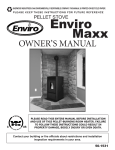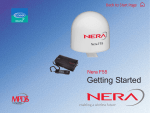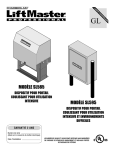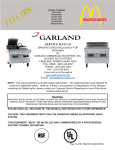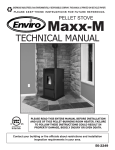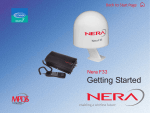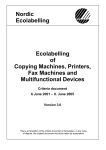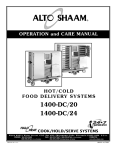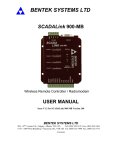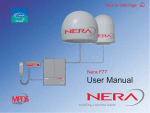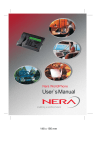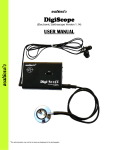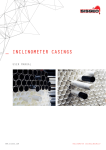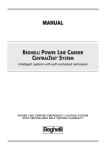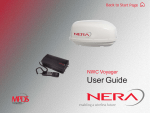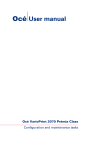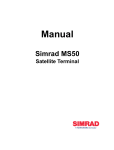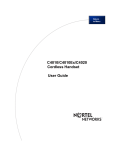Download Installation Manual
Transcript
Back to Start Page Nera F77 Installation Manual ISDN ALPHA Saturn F May 01 09:15 4.8 Speech Nera F77 Safety Warnings, Cautions and Warranty General To avoid interference, do not run cables parallel to AC wiring, or near fluorescent lights or other high magnetic or electrical fields. Interference from this kind of sources causing equipment to be faulty or fail working properly will automatically void warranty conditions. Access to the interior of the equipment shall be made by a Nera qualified technician only. The equipment shall be installed by a Nera SatCom approved Installation & Service Agent. Warranty is not valid until the "Nera Satcom AS Warranty Certificate" (at the back of the Registration and Warranty Certificate booklet enclosed with the equipment) is signed by the approved Installation & Service Agent, and returned to Nera SatCom. Grounding Grounded AC power socket shall be installed near the equipment and shall be easily accessible. Connection to all type of equipment meant for operation of the unit should be done while the unit is powered off. Peripheral equipment using mains shall be connected to a grounded AC power socket. Cables and connections Cables longer than 5 metres must be shielded. All peripheral equipment must be grounded. Cables exceeding their maximum lengths require special arrangements, cable extenders, short haul modems etc. - ISDN telephone 100 m 0.22 mm2 min - Analogue telephone 150 m 0.22 mm2 min - USB 5 m Standard cable - RS-232 3 m Standard cable - RS-422 100 m 0.22 mm2 min Always follow the installation guidelines described later in this manual for each type of interface. Ventilation of the Below Deck Equipment Ambient temperature range: 0 - 45oC. To ensure adequate cooling of the MCU a 10 cm unobstructed space must be maintained above and below the unit. When wallmounted, ensure sufficient space above the MCU to permit removal of the Modem Unit and Power Supply Unit. See "Placing the Main Communication Unit (MCU)". Failure to comply with the above rules for installation will automatically void the warranty. © Nera SatCom AS, 2003 A MEMBER OF CIRM SAFETY INSTRUCTION WARNING Do not open the equipment. ELECTRICAL SHOCK HAZARD Only qualified personnel should work inside the equipment. WARNING Turn off the power immediately if water leaks into the equipment or the equipment is emitting smoke or fire. Continued use of the equipment can cause fire or electrical shock. Do not place liquid-filled containers on the top of the equipment. Do not approach the radome closer than 5 meters when it is transmitting. The radome emits radio waves which can be harmful to the human body, particularly the eyes. Leave the equipment powered while underway. Distress cannot be communicated unless the equipment is powered. Do not disassemble or modify the equipment. Fire, electrical shock or serious injury can result. Fire or electrical shock can result if a liquid spills into the equipment. Do not operate the equipment with wet hands. Electrical shock can result. Keep heater away from equipment. Heat can alter equipment shape and melt the power cord, which can cause fire or electrical shock. Any repair work must be done by a Nera approved Regional Service Centre. Improper repair work can cause electrical shock or fire. Use the proper fuse. Fuse rating is shown on the equipment. Use of a wrong fuse can result in damage to the equipment. Nera SatCom AS reserves the right to change the design and specifications of the equipment without notice. CONTENTS SYSTEM PLANNING INSTALLATION APPENDIX 1-6 APPENDIX 7 APPENDIX 8 APPENDIX 9 APPENDIX 10 APPENDIX 11 APPENDIX 12 APPENDIX 13 Rev Date: February 2006 Nera F77 Continuing the Saturn tradition Below Deck Equipment - BDE .................................................................. 6 Above Deck Equipment - ADE .................................................................. 7 Placing the Antenna.................................................................................. 6 Designing the Antenna mast ................................................................... 10 Outline dimensions of Antenna radome (mast mounted version) ........... 11 Outline dimensions of Antenna radome (deck mounted version) ............ 12 Physical characteristics of main units ..................................................... 13 MCU connectors ..................................................................................... 15 Upper connector panel ........................................................................... 15 MCU connectors ..................................................................................... 16 Lower connector panel ........................................................................... 16 Example of BDE installation ................................................................... 17 Example of Nera F77 installation cabling arrangement ........................... 18 Placing the Main Communication Unit (MCU) ......................................... 19 Placing the Distress Alarm Unit & ISDN Handset ................................... 19 Placing the ISDN Handset as a standard telephone ............................... 20 Placing the telefax (option) ..................................................................... 20 Placing the PC (option) ........................................................................... 20 Placing analogue telephones (option) ..................................................... 20 Grounding considerations ....................................................................... 21 Laying cables .......................................................................................... 23 Telephone wiring .................................................................................... 24 Unpacking .............................................................................................. 25 Installing the Above Deck Equipment (ADE) ........................................... 25 Mast mounted version ............................................................................ 25 Deck mounted version ............................................................................ 26 ADE - Connecting coaxial cable to Mast Mounted Antenna .................... 27 ADE - Connecting coaxial cable to Deck Mounted Antenna ................... 28 Installing the Below Deck Equipment (BDE) ........................................... 29 Location and grounding of units .............................................................. 29 BDE - Example of local or near-by installation ........................................ 30 BDE - Example of remote installation ..................................................... 31 Connection Box QUFC 911 918 (option) ................................................ 32 Nera ISDN Handset ................................................................................ 33 Handset holder/cradle ............................................................................ 33 Mounting the Main Communication Unit (MCU) ...................................... 34 BDE - Connecting the coaxial cable to the MCU ..................................... 35 Examples of Below Deck Equipment ...................................................... 36 ISDN telephones/equipment ................................................................... 37 ISDN cable lengths ................................................................................. 37 ISDN wall socket .................................................................................... 38 Distress Alarm Unit ................................................................................. 39 ISDN bus termination ............................................................................. 39 Analogue telephones .............................................................................. 40 Wall socket for analogue telephone/telefax gr.3 (option) ........................ 40 PC - asynchronous data communication ................................................ 41 NMEA-0183 input sources (complies with IEC 61162-1) ........................ 42 Mounting connector type 11N-50-3-54 (for cable RG223/U) ................... 43 Mounting connector type 11N-50-7-5 (for cables RG214/Ethernet 06230) ... 44 Mounting connector type 11N-50-10-4 (for cable S10172 B-11) ............. 45 Mounting connector type 11N-50-12-10 (for cable RF 1/2" 50) ............... 46 Mounting connector type 11N-50-23-10 (for cable RF 7/8" 50) ............... 47 Mounting connector type 11N-50-32-2/11N-50-42-2 (for cables RF 1 1/4"/15/8" 50) 48 Main items .............................................................................................. 49 Cable pinouts .......................................................................................... 51 Serial printer settings .............................................................................. 53 Reception of L-band Broadcast signals .................................................. 54 Activation of "Radio Silence" ................................................................... 55 Azimuth Angle Map ................................................................................. 56 Elevation Angle Map ............................................................................... 56 Previous type radome ............................................................................. 57 Publication No.: 101442 (Rev. 1.3) 5 Installation Manual SYSTEM Below Deck Equipment - BDE Main Control Unit The Nera F77 Main Communication Unit (MCU) - which constitutes the major electronic part - is designed for wall or desktop installation. The MCU supplies 48 VDC power to the ADE through the coaxial cable. The MCU may be equipped with AC or DC power supply. The AC mains input is 100 - 240 VAC ±10%. The DC input is 20 - 32VDC with an alternative input for automatic switchover in case of main input failure. The power requirement is approx. 40 W in receive/idle mode, and approx. 150 W in transmit mode. A CD supplied with the equipment contains a program for control and operation from PC. See the Nera F77 - User Manual. Nera ISDN Handset The Nera ISDN Handset keypad and built-in display allows dialing and control of the MCU and antenna. Distress Alarm The Distress Alarm Unit together with the Nera ISDN Handset provides remote activation of an alert transmission and indication of incoming distress calls. Accessories • • • • • • • Basic Equipment Additional Nera ISDN Handsets ISDN telephones Analogue DTMF telephones Group 3 and Group 4 telefax PC Printer w/RS-232 serial interface One additional Distress Alarm Unit (DA) Main Communication Unit MCU Nera ISDN Handset Distress Alarm ISDN Telenor IOR Ready for call DISTRE SS Saturn F OK DEL 1 2 4 ghi 7 pqrs abc 3 def 5 jkl 6 mno 8 tuv 9 wyz 0 Ner a F7 7 Accessories ISDN ISDN Telenor IOR Ready for call Telenor IOR Ready for call OK OK DEL 1 DEL 1 2 4 ghi 7 pqrs 4 ghi jkl 6 mno 7 pqrs tuv 9 wyz abc 3 Additional ISDN telephones Nera ISDN Handsets 6 2 def 5 8 abc 3 def 5 jkl 6 mno 8 tuv 9 wyz 0 0 DISTRE SS Analogue telephones (wall or desk) Telefax (Group 3 or 4) PC Serial printer Saturn F Additional Distress Alarm Nera F77 Continuing the Saturn tradition SYSTEM Above Deck Equipment - ADE The Nera F77 Above Deck Equipment consists of: • Servo stabilized antenna dish with RF-Transceiver • Mast mounted radome, or • Deck mounted radome Antenna dish Servo stabilized pedestal Mast mounted radome (cutaway view) GPS receiver Rotary joint Access hatch (mast mounted version only) RF-Transceiver BDE - ADE coaxial cable Deck mounted radome (cutaway view) Total of equipment connected: 7 8 1 1 1 ISDN devices (2 with Distress Alarm Unit) Analogue devices RS-232 device RS-232 or RS-422 device USB device Nera F77 Continuing the Saturn tradition 7 Installation Manual PLANNING Placing the Antenna Radome type Nera F77 is delivered either with mast mounted or deck mounted radome. See previous page. The mast mounted version includes a hatch which provides access for service and repair, whereas on the deck mounted version the radome top must be lifted off before servicing. Avoiding obstructions The antenna has a beamwidth of ±7.5 degrees and ideally requires a free line of sight in all directions. Any obstruction will cause blind sectors, resulting in signal degradation or even loss of communication with the satellite. Degradation of the satellite signal can only be completely avoided by placing the antenna higher than any obstructions. This is often not feasible and a compromise must be made to reduce the number of blind sectors and cost of installation. The degree of signal degradation depends on the size of the obstructions; the distance to them must therefore be considered. Preferably, all obstructions within 3 m of the antenna should be avoided. Obstructions less than 15 cm in diameter can be ignored beyond this distance. Radiation precautions Passengers should not be admitted in areas closer than 5 m from the antenna. However, no restrictions are required when the antenna radome is installed at least 2 m above the highest point accessible to passengers. Personnel should not be close to the antenna for periods of more than 1 hour per day without switching off the RF transmitter. MICROWAVE RADIATION ! NO ADMITTANCE WITHIN 5 M Based on 8 W/m2 8 FREE ADMITTANCE AT DECK LEVEL AT LEAST 2 M BELOW RADOME Nera F77 Continuing the Saturn tradition PLANNING Avoiding interference Do not locate the antenna close to interfering signal sources, or in such a position that the source (e.g. radar-antenna) radiates directly into the Nera F77 antenna. AVOID INTERFERENCE E.G. FROM THE RADAR 10 CM RADAR 10° 10° The Above Deck Equipment (ADE) should be separated as far as possible from other transmitters, and preferably by at least 5 m from the antenna of other communication or navigation equipment, such as the antenna of the satellite navigator, the VHF antenna, radar equipment, or other Inmarsat equipment. Compass safe distance For installation on British or Norwegian vessels, the antenna should be located at a distance of at least 1.0 metres from the magnetic steering compass. Be aware that requirements may vary from one country to another. Other precautions Do not place the antenna close to the funnel, as smoke deposits will then eventually degrade antenna performance. The antenna should be installed so that severe vibration and shock are avoided. Nera F77 Continuing the Saturn tradition 9 Installation Manual PLANNING Designing the Antenna mast (mast mounted version) The mast must be designed to carry the weight of the antenna unit, approximately 59 kg. It must be able to withstand wind forces of up to 120 knots on the radome as well as the onboard vibration levels. The radome is 1.076 m high and has a maximum diameter of 1.165 m. The top end of the mast should be fitted with a flange with holes matching the bolts extending from the bottom of the radome. See figure below. The flange must not be so large as to interfere with the hatch at the bottom of the antenna unit. NOTE: On ships with excessive vibration the mast must be supported by stays or other adequate means. If the height of the mast makes it necessary to climb up to the antenna unit, a ladder must be provided on the mast column. A guard rail must be attached to the upper section for safety purposes. If the height of the mast exceeds approximately 4.5 metres, an access platform should be attached to the mast approximately 1 metre below the radome bottom. Be aware that requirements may vary from one country to another. ANTENNA UNIT ACCESS HATCH MAST FLANGE HOLE DIA 22 MM 10 MM STEEL PLATE 0 35 M M 247.5MM 330MM 247.5MM 330 MM Antenna Unit Mounted on Mast 10 Nera F77 Continuing the Saturn tradition PLANNING Outline dimensions of Antenna radome (mast mounted version) 1076MM 45MM Optional steel Antenna Mast, R906569 Weight: 85 kg 1165MM SEEN FROM BELOW DIA 140MM ANTENNA MOUNTING STUDS (4), M12 LIFTING LUGS (3) GROUNDING STUD 2000MM COAXIAL CABLE ENTRY 330MM ACCESS HATCH DRAIN HOLE 60MM 480MM Weight: approx. 59 kg 600MM For welding onto deck Nera F77 Continuing the Saturn tradition 11 Installation Manual PLANNING Outline dimensions of Antenna radome (deck mounted version) 1047MM 80MM 925MM 247.5MM 247.5MM M 0M COAXIAL CONNECTOR 35 ANTENNA MOUNTING STUDS (4), M12 DRAIN HOLE GROUNDING STUD SEEN FROM BELOW M10x50 SOCKET HEAD UNBRAKO SCREWS (RADOME TOP FASTENERS) Weight: approx. 45 kg 12 Nera F77 Continuing the Saturn tradition PLANNING Physical characteristics of main units ����������������������������� ����������������������� ���������������������� ����� �� �� ��� ����� ��� ��� �� ��� ������� �� ���� �� �� ����� ������������ ��������������������� ������������ ������ ���������� ������������������ ����� ����� ���� ������ ������������������� ���������������� �� ��� � � ��� � ��� � ��� � ��� � ��� � ���� � ��� � ��� ���� � �� � ���� ������ �� �� �� �� ����������� �������� � ����� �� �� �� ���� �������������� ��������������� ������������������� �� �� ����������� ���������� ���������� �� Continuing the Saturn tradition �� �� Nera F77 ���� � �������������� ��� �� � �������� ������ ���� �� ������ ����� ������ 13 Installation Manual PLANNING Physical characteristics of main units cont'd ISDN wall socket (option) Connection box (option) 102176 QUFC 911 918 82 m m 50 170 mm mm 30 mm 70 mm 200 mm Cable entry to be cut D ia 50 3 20 32 57 6.5 125 6.5 ISDN junction box (option) 20 102174 20 90 160 20 mm Weight: 0.6 kg 48 mm Analogue telephone/telefax wall socket (option) 90 R 906 676/1 m m 52 mm 20 mm D ia 23 4 30 58 mm 26 12 Dia 3.5 20 23 17 18 17 41.5 14 Nera F77 Continuing the Saturn tradition PLANNING MCU connectors Upper connector panel AC POWER SUPPLY POWER INDICATOR MODEM UNIT ON/OFF SWITCH O FUSES 2 x T5A Slow Blow 250V I Fuses: 2xT5A 250V 100-240VAC (50/60Hz) 180W SIM CARD BROADBAND (DGPS) RF SIM CARD INSIDE WHEN CHANGING MODEM UNIT REMOVE COVER AND TAKE OUT SIM CARD 100-240 AC MAINS CONNECTOR SIM CARD (inside cover) L-BAND OUTPUT (must be terminated) ANTENNA CONNECTOR DC POWER SUPPLY SOURCE 1 48V ON/OFF POWER POWER SWITCH INDICATOR INDICATOR (lights red when source 2 is active) Source 1: 20 - 32VDC Fuse: 16A SLOW BLOW SOURCE 2 POWER INDICATOR Source 2: 20 - 32VDC Fuse: 16A SLOW BLOW For lower panel, see next page Nera F77 Continuing the Saturn tradition 15 Installation Manual PLANNING MCU connectors Lower connector panel Screw terminal blocks TEL 1 - 4, and additional RJ45 connectors for TEL 3 and 4: Connection of 2W analogue telephones and G3 fax 4 6 RS-422: serial port for connection of data equipment with up to 100 metres cables: 64kbps data MPDS operation and configuration from PC TX RX RX TX ISDN 4 5 3 1 8 8 1 1 8 8 1 1 8 6 RX 6 TX 3 RX 5 ISDN ISDN TEL 3 USB ISDN ISDN: Connectors/RJ45 Services: 4.8kbps compressed speech 64kbps speech 64kbps data service (UDI) 128kbps data service (UDI) 56kbps data service (V110) 110kbps data service (V110) 64kbps audio service (3.1kHz) USB: serial data port for: operation and configuration from PC. 64kbps data service (UDI) MPDS Note! Use shielded ISDN cable RS-232: 9-pin serial data ports for: operation and configuration from PC. software download (RS-232A) 64kbps data service (UDI) MPDS serial printer 16 4 TX TEL 4 TEL 2 RX RS-422 RX TX TX 8 1 RX 3 RX 5 TX 6 RX 3 TX RX RX TX 5 RX TX 4 ISDN ISDN TEL 4 TX * On early versions: ISDN * ISDN TX TEL 3 TEL 1 IND SW SILENCE NMEA NMEA: Connection of NMEA-183 input NMEA SILENCE: Connection of "Radio Silence Box" 5 4 3 2 1 5 4 3 2 1 9 8 7 6 9 8 7 6 RS-232 B RS-232 A Nera F77 Continuing the Saturn tradition PLANNING Example of BDE installation RF cable to/from Antenna Analogu e tel/fax Main Commun ication Unit Distress ISDN Alarm Handset ISDN bus Nera F77 DISTR ESS ISDN Telenor IOR Ready for call OK DEL 1 2 4 ghi 7 pqrs 3 abc def 5 jkl 6 mno 8 tuv 9 wyz 0 Telefa x Groun d foil PC Rem ote insta llatio ns Distr Alarmess I SD HanN dse DIS TR ES S Satur nF ISDN Telenor IOR Ready for call OK DEL 1 2 4 ghi 7 pqrs Nera F77 Continuing the Saturn tradition abc 3 def 5 jkl 6 mno 8 tuv 9 wyz 0 t Rem ote insta llatio ns Ana gu Telelo phone e 17 Installation Manual SYSTEM Example of Nera F77 installation cabling arrangement The installation includes four Nera ISDN Handsets (two w/Distress Alarm Unit), Group 3 and 4 telefaxes, PC w/printer, Data Equipment and two Analogue Telephones. RX RX TX TX RX RX ISDN TX ISDN TX TEL 3 TEL 1 NMEA SW IND NMEA MCU CONNECTOR PANEL SILENCE 4 5 3 6 4 5 3 6 4 5 3 6 4 5 3 6 ISDN ISDN TEL 4 8 1 1 8 8 1 1 8 8 1 1 8 5 4 3 2 1 5 4 3 2 1 Nera ISDN Handset ISDN TX RX RX RX RX TX TX TX TEL 4 RS-422 TEL 2 RX TX RX TX 9 8 7 6 ISDN ISDN TEL 3 USB 9 8 7 6 RS-232 A RS-232 B ISDN Distress Alarm ISDN Telenor IOR Ready for call Saturn F Analogue telefax (G3) PC PC Serial printer Digital telefax (G4) Radio Room Bridge Distress Alarm Digital telefax (G4) OK Saturn F DEL 1 Analogue telephone ISDN telephone ISDN Telenor IOR Ready for call 2 4 ghi 7 pqrs abc 3 def 5 jkl 6 mno 8 tuv 9 wyz 0 Nera ISDN Handset Nera ISDN Saloon Nera ISDN Handset Analogue telephone ISDN Telenor IOR Ready for call PC OK DEL 1 4 ghi 7 pqrs 2 abc 3 def 5 jkl 6 mno 8 tuv 9 wyz 0 Nera ISDN Owner's Cabin 18 Captain's Cabin Nera F77 Continuing the Saturn tradition PLANNING Placing the Main Communication Unit (MCU) Ventilation Distance Falling water Grounding Temperature Mounting The Main Communication Unit should be placed in a ventilated area. To ensure adequate cooling of the MCU a 10 cm unobstructed space must be maintained above and below the unit. A space of 10 cm above the ����� ���� MCU is also required to ����� allow removal of units. The MCU must not be ����� �� mounted in such a way that there is danger of falling water hitting the connector panel. If such an installation is impossible, a protection cover is recommended installed above the MCU. For grounding, see ����� "Grounding considerations" and "Location and grounding of units". Ambient temperature range ����� ���� 0O - 45O C. ����� ���� The MCU is manufactured as a cabinet for wall or desktop installation with dimensions as shown. Six holes through the MCU mounting plate allows the unit to be secured to the wall or desk top. Placing the Distress Alarm Unit & Nera ISDN Handset Control The Distress Alarm Unit is operated in conjunction with a Nera ISDN Handset. ������ The Nera ISDN Handset functions as a dis�� play and communication unit for alert transmission. It may also be used for normal voice communication. Up to two (2) Distress Alarm Units, together with Nera ISDN Handsets, may be connected in series. The units may be installed anywhere onboard the vessel. Four separate ISDN ports (part of the ISDN bus) are available on the MCU as RJ45 jacks or screw terminal blocks. Max cable length: 100 m See "ISDN telephones/equipment and ISDN cable lengths". �������� ���� ������������������� ���������������� Distress Alarm Units �� ��� � � � ��� � ���� ��� � ��� � ��� � ��� � ��� � ��� � Connection Nera F77 Continuing the Saturn tradition 19 Installation Manual PLANNING Placing the Nera ISDN Handset as a standard telephone Location The Nera ISDN Handsets may be installed as standard telephones without Distress Alarm units. The units may be installed anywhere onboard the vessel. Four separate ISDN ports are available on the MCU as RJ45 jacks or screw terminal blocks. ISDN Telenor IOR Ready for call OK DEL 1 2 4 ghi 7 pqrs abc 3 def 5 jkl 6 mno 8 tuv 9 wyz 0 Placing the telefax machine Digital fax Analogue fax A digital telefax (Group 4) can be connected to the ISDN bus for transfer at 64 kbps rate. An analogue telefax (Group 3) can be connected to the TEL4 port (default 9.6 kbps fax). (3.1 kHz audio can also be used for Group 3 fax, providing typically 14.4 kbps transfer speed.) Placing the PC Distance to PC Control & configuration Data service A PC w/ISDN card can be connected to the ISDN bus for 64 kbps rate data communication up to 100 m away from the MCU. A PC connected to the USB/RS-232/ RS-422 port can also be used for control and configuration of the Main Communication Unit. This requires that the vtLite Mobile program accessible on the Nera F77 CD is installed. Connection to the USB/RS-232/RS422 port also allows 64 kbps data transmission. See the User Manual. Cable lengths: • ISDN port: • USB port: • RS-232 ports: • RS-422 port: see "ISDN telephones/equipment " and "ISDN cable lengths" see "Appendix 8, cable pinouts" Placing analogue telephones Analogue ports Number of telephones 20 Analogue 2-wire telephones can be installed anywhere onboard the vessel. Four separate analogue ports TEL1-TEL4 are available on the MCU. TEL3 and TEL4 are in addition available as RJ45 jacks. Two telephones can be connected in parallel on each line, providing a maximum of eight analogue telephones. Nera F77 Continuing the Saturn tradition PLANNING Grounding considerations A successful installation of a maritime satellite terminal must take into account the noisy environment in which the equipment shall operate. Electrical noise The electrical environment on board a ship is usually quite noisy. Powerful electrical installations cause voltage variations and transients, as well as low and high frequency noise. Radio and radar equipment radiate radio frequency signals which frequently impregnate cables on board with unwanted interference. Ground plane Most ships have a steel hull. One should think that the steel construction of the ship would constitute a good ground plane. This is often not quite true. Rust, other forms of corrosion, paint and grease, often prevent a good ground connection. A consequence of this is that high energy power distribution on board a ship can cause significant ground potential differences. Antenna unit Adequate grounding of the Antenna Unit depends on the fastening bolts making good contact with the top flange of the mast. This is obtained by removing paint and using enclosed toothed washers and nuts. See "Outline dimensions of the antenna radome . . ," Antenna cable The screen of the antenna coaxial cable must be terminated to ground both at the antenna pedestal and at the MCU. The antenna cable will automatically be terminated to ground when connected provided the Antenna and the MCU are properly installed. Below Deck Equipment The MCU must be provided with a good electrical connection to the ship’s hull for grounding. This is obtained by using copper foil. (See Installation: "Location and grounding of units".) Length of copper foil/10 cm should not exceed 300 cm. The foil should be connected to ship's hull (deck or roof) by hard-soldering (or screws) to steel. Mains power/ground Mains ground must be checked against the common grounding point (MCU mounting plate). It is important to use the same mains branch for additional equipment connected to the MCU (fax, PC w/printer etc.). Nera F77 Continuing the Saturn tradition 21 Installation Manual PLANNING Grounding considerations cont'd Location of the MCU for best possible grounding. See also INSTALLATION: "Location and grounding of Units". MCU min. 10 cm Desktop max.3m 22 Nera F77 Continuing the Saturn tradition PLANNING Laying cables General The coaxial cable for connection between the MCU and the Antenna Unit should, if possible, be laid before the equipment arrives. Make sure sufficient length of cable is ordered. Where exposed to mechanical wear (on deck, through bulkheads etc.), the cable should be protected by steel pipes. Standard procedures should otherwise be followed for cabling in ship installations. Special attention to existing safety regulations is required if the cable passes through zones where there may be flammable or explosive gases. Use suitable gasproof cable glands or bushings. Double screen 50 ohm coaxial cable must be used. The maximum length of the coaxial cable is limited by the DC and RF loss through the cables (including pigtails): Maximum DC loss: R loop 2.0 ohm Minimum/maximum RF attenuation at 1.6 GHz:4/23 dB Maximum power consumption: - transmit mode 150W - receive mode 40W The table below lists suitable double screened coaxial cables between MCU and ADE: � �������������������������������������� ������ ��������� ����������� �������� ������������� �������� ������� ������ �������� ���������� ������ ������ ����� ������ ����������� ����������� ������ ������� ������ ������� ���������� ������������� ������� ������ �������� ����������� ���������� ������� ������ �������� ������������ ����������� ���������� ������� ������ �������� ������������ ����������� ������������� ���� �������� ����� ��������� ���������� ���������������� ���������� ������ ��������� ����������� �������� ������������� ������������������������������������������������������ �������� ������ ���������� ��������������������� ������ �������� ���������� At the Antenna Unit A free end of approximately 1.5 m of the antenna cable above the radome bottom should be provided for connection to the coaxial connector in accordance with the installation instructions in "BDE - Connecting the coaxial cable to the MCU ". At the Main Communication Unit The coaxial cable from the Antenna Unit should be given a free end of approximately 0.5 m at the MCU location. Nera ISDN Handset, Distress Alarm Unit, telefax or analogue telephone Choose the position for the required wall sockets and lay the cables leaving a free end of 0.5 m. Also allow a free end of 0.5 m at the Termination Box. Nera F77 Continuing the Saturn tradition 23 Installation Manual PLANNING Telephone wiring Distress Alarm DISTRESS Nera ISDN Handset ISDN Telenor IOR Ready for call 123 456 MCU connector panel Saturn B ALARM ACKNOWLEDGE 12345678 78 RJ45 1 1 2 RX+ 3 TX+ 4 TX - 5 2 DISTRESS BUTTON TB1 1 TX+ 2 TX - 3 RX - 4 RX+ 3 4 5 RX - 6 6 7 7 8 8 ISDN (terminal block) ALARM BUZZER RX+ TX+ TX - RX - TB2 1 2 3 4 4 5 3 6 TX+ TX RX+ RX - To next Distress Alarm or ISDN wall socket ISDN (RJ45 connector) 123 Nera ISDN Handset ISDN Telenor IOR Ready for call 456 78 1 2 RX+ 3 TX+ 4 TX 5 RX 6 7 8 123 12345678 1 2 3 4 5 6 7 8 3 4 5 6 456 12345678 78 1 2 3 4 5 6 7 8 1 2 RX+ 3 TX+ 4 TX 5 RX 6 7 8 ISDN WALL SOCKET RJ11 (6/4) RJ45 connector 123 Analogue telephone 1 2 4 5 7 8 P 3 6 9 0 # S Re 1 2 3 4 5 6 RJ45 12345678 456 456 1 2 3 4 5 6 7 8 3 4 CONNECTION BOX 24 123 FAX/TEL3 (RJ45 connector) 78 12345678 1 2 3 1 2 3 4 5 6 7 8 4 5 6 7 8 TEL1-3 (terminal block) Nera F77 Continuing the Saturn tradition INSTALLATION Unpacking Open all boxes supplied and check the contents with the enclosed packing list. Inspect units and parts for possible transport damage. Installing the Above Deck Equipment (ADE) Mast mounted version Installation on the mast The ADE radome is furnished with 3 lifting lugs accessible from underneath the radome, see figure below. The radome is delivered with a rope attached to the lugs, ready for lifting of the ADE by crane. Remove the straps fastening the radome to the transport pallet. Carefully start lifting the ADE. Personnel must not pass underneath the ADE during hoisting operations. Watch your hands! Align the bolts extending down from the bottom with the holes through the mast flange, and lower the unit gently until it rests on the mast. Secure the ADE to LIFTING the mast flange ROPE using the enclosed 101575 toothed washers and nuts. Tighten the nuts applying a torque of 100 Nm. Finally, remove the lifting rope. WARNING! WARNING! Coaxial cable entry holes Lifting lug (3) Grounding stud To obtain good grounding, remove paint from mast in area where the nut of the grounding stud is fastened. Use toothed washer included. Nera F77 Continuing the Saturn tradition Nut Toothed washer 25 Installation Manual INSTALLATION Installing the Above Deck Equipment cont`d Deck mounted version Installation on the mast The deck mounted radome is delivered with a rope, ready for lifting of the ADE by crane or similar. Carefully start lifting the ADE. WARNING! Personnel must not pass underneath the ADE during hoisting operations. WARNING! Watch your hands! Align the bolts extending down from the bottom with the holes drilled through the fixing structure, and lower the unit gently until it rests properly. Secure the ADE using the enclosed toothed washers and nuts. Tighten the nuts applying a torque of 100 Nm. Finally, remove the rope. Keep the rope for hoisting the antenna down for service. INSTALLATION & SERVICE ROPE 102188 Coaxial cable connector Grounding stud To obtain good grounding, remove paint from mast in area where the nut of the grounding stud is fastened. Use toothed washer included. 26 Nut Toothed washer Nera F77 Continuing the Saturn tradition INSTALLATION ADE - Connecting coaxial cable to Mast Mounted Antenna r ca min bl = 1 e 0 di x a Antenna Unit (reduced scale) r Radome base RF Cable from BDE (MCU) Data Cable tie RF Pedestal 48 VDC Hatch Radome base RF Cable 1 Strip the cable leaving a free end of approximately 1 metre, ensuring adequate slack for connection to the radome coaxial socket, as shown. Pedestal base 2 Mount the N-type connector to the coaxial cable in accordance with the instructions (see Appendices 1 – 6). 3 Connect the RF plug to the Antenna Unit coaxial connector as shown. Antenna Cable from MCU N-connector Nera F77 Continuing the Saturn tradition Bracket The minimum bending radius of the coaxial cable is 10 times the cable diameter. Radome base 27 Installation Manual INSTALLATION ADE - Connecting coaxial cable to Deck Mounted Antenna r camin = ble 10 dia x r Receptacle mounted in alternative position. Shifted from inside of radome. N-connector Data 1 Strip the cable leaving a free end of approximately 1 metre, ensuring adequate slack for connection to the radome coaxial socket, as shown. 2 Mount the N-type connector to the coaxial cable in accordance with the instructions (see Appendices 1 – 6). 48 VDC RF 3 Connect the RF plug to the Antenna Unit coaxial connector as shown. If required, use a coax angle adapter. The minimum bending radius of the coaxial cable is 10 times the cable diameter. RF cable from MCU 28 Nera F77 Continuing the Saturn tradition INSTALLATION Installing the Below Deck Equipment (BDE) Location and grounding of units To next Distress Unit & ISDN Handset Antenna Cable Main Communication Unit Distress Alarm Unit Nera F77 ISDN Handset ISDN Telenor IOR Ready for call Mains Desktop Alternative method: brazing solder Common ground Bolt M10 (cut to suitable length) Foil end to be folded Nut M10 Copper foil Nut M10 Lock washer M10 Washer M10 Wood etc. Bulkhead (iron) Nera F77 Continuing the Saturn tradition Seen from below 29 Installation Manual INSTALLATION BDE - Example of local or near-by installation The installation includes five Nera ISDN Handsets (two w/Distress Alarm Unit), Group 3 and Group 4 telefaxes, PC and two analogue telephones using connection box. ISDN TX TX RX TX TX RX RX ISDN RX TEL 1 TEL 3 NMEA SW IND NMEA MCU CONNECTOR PANEL SILENCE 4 5 3 6 4 5 3 6 4 5 3 6 4 5 3 6 ISDN ISDN TEL 4 8 1 1 8 8 1 1 8 8 1 1 8 5 4 3 2 1 5 4 3 2 1 Nera ISDN Handset ISDN RX TX RX RX TX TX TX RX TEL 2 TEL 4 TX RX RS-422 RX TX 9 8 7 6 ISDN ISDN TEL 3 USB ISDN 9 8 7 6 RS-232 A RS-232 B ISDN Telenor IOR Ready for call Nera F77 Analogue telefax (G3) PC PC Radio Room Bridge ISDN Telenor IOR Ready for call OK Nera F77 DEL 1 2 4 ghi 7 pqrs 3 abc def 5 jkl 6 mno 8 tuv 9 wyz 0 Connection Box QUFC 911 918 24 J6 Nera ISDN Handset 1 8 18 ISDN J5 Telenor IOR Ready for call J4 11 10 J3 Nera ISDN Handset OK DEL 1 2 4 ghi 7 pqrs abc 3 def 5 jkl 6 mno 8 tuv 9 wyz 0 J2 J1 1 DP2 1 DP1 Analogue telephone To common ground 30 J1 - J6: RJ45 w/grounded metal housing Nera F77 Continuing the Saturn tradition INSTALLATION BDE - Example of remote installation The installation includes two Nera ISDN Handsets connected to the ISDN bus via wall boxes with two 8-pin RJ45 jacks and analogue telephone. ISDN Nera ISDN Handset ISDN Telenor IOR Ready for call Nera ISDN Handset PC OK DEL 1 2 abc 3 Telenor IOR Ready for call OK DEL 1 2 abc 3 def 4 ghi 5 jkl 6 mno 7 pqrs 8 tuv 9 wyz Digital telefax (G4) 0 def 4 ghi 5 jkl 6 mno 7 pqrs 8 tuv 9 wyz 0 Nera ISDN Nera ISDN Saloon Captain's Cabin Analogue telephone Owner's Cabin Nera F77 Continuing the Saturn tradition 31 Installation Manual INSTALLATION Connection Box QUFC 911 918 (option) Inside Connection Box 24 J6 1 8 18 J5 J4 11 10 J3 J2 J1 1 DP2 1 DP1 Nera Display Handset or ISDN Wiring diagram 24 8 18 J6 1 11 Analogue connections 4 GND 1 DP1 32 J5 3 4 J4 3 10 4 J3 3 4 J2 3 4 J1 3 1 DP2 Nera F77 Continuing the Saturn tradition INSTALLATION Nera ISDN Handset The ISDN Handset is to be plugged into the ISDN socket located on the connector panel of the MCU, or to the Distress Alarm Unit (if installed). Note! It is not recommended to extend the handset cable by more than 6 m. ISDN Telenor IOR Ready for call OK DEL 1 2 abc 3 def 4 ghi 5 jkl 6 mno 7 pqrs 8 tuv 9 wyz 0 Handset holder/cradle Desk mounted The handset holder/cradle may be desk mounted or wall mounted. Wall mounted Attach the holder to the wall or desktop with four 4 mm wood screws or tapping screws. Place the Handset on the holder as shown. click! Hook ON magnet Nera F77 Continuing the Saturn tradition 33 Installation Manual INSTALLATION Mounting the Main Communication Unit (MCU) 1 Unscrew the Power Supply Unit and the Modem Unit and pull them carefully out. Remove the cover protecting the connector panel. ply it em Un r we Po nit U p Su od M Contains: cto ne n Co p a n e l Connector Board (CIB) C o n n e c to r el an rp • Fwd Id • ISN • Paid functions 2 Attach the bottom plate to the wall using six wood screws or tapping screws. Ensure a free space above and below the MCU of at least 10 cm for adequate cooling, and to allow removal of the Modem Unit and Power Supply Unit. 3 Mount the Power Supply Unit and Modem Unit. Remount the connector panel cover after connection of cables. C o n n e c to r p a n e l 34 NOTE! Secure the MCU even when desk mounted. Nera F77 Continuing the Saturn tradition INSTALLATION BDE - Connecting the coaxial cable to the MCU 1 Strip the Antenna coaxial cable leaving sufficient slack for connection to the MCU or "pigtail". 2 Mount the N-plug on the cable in accordance with the instructions (see Appendices 1 - 6). 3 For thicker coax cable, use the "pigtail" for connection of the Antenna cable to the MCU. RF P igt ail DGPS N/female Ner aF 77 Nera F77 Continuing the Saturn tradition N-connector From Antenna 35 Installation Manual INSTALLATION Examples of Below Deck Equipment ISDN RX+ TX - TX+ RX- RX+ ISDN ISDN ISDN TEL 4 TX - TX+ TX - - RS-422 RX- ISDN - TEL 1 TEL 3 NMEA - - - SW IND SILENCE NMEA + MCU - Main Communication Unit RS-232 B ISDN RS-232 A Distress Alarm Unit Nera F77 Nera ISDN ISDN ISDN Telenor IOR Ready for call Telenor IOR Ready for call OK OK DEL 1 2 4 ghi 7 pqrs abc ISDN wall socket DEL 3 def 5 jkl 6 mno 8 tuv 9 wyz 0 Nera ISDN Handset 1 2 4 ghi 7 pqrs abc 3 def 5 jkl 6 mno 8 tuv 9 wyz 0 Digital telefax (G4) 36 Analogue telephone Nera ISDN Handset PC w/ISDN interface Analogue telefax (G3) Serial printer PC Nera F77 Continuing the Saturn tradition INSTALLATION ISDN telephones/equipment ISDN equipment is connected to the ISDN outlets on the MCU connector panel, either to terminal blocks or RJ45 jacks. An ISDN bus can be connected to one of the ISDN outlets. Max. extension length: 100 m, min. 0.22 mm2. Screen ISDN bus Local equipment ISDN wall socket Ma Ma Nera ISDN Nera ISDN x5 m x1 0m wit ho ut sc cre Remote equipment ree Warning! Attempting to connect Ethernet equipment to an ISDN RJ45 outlet may cause damage to the Ethernet equipment. 5m en n ax hs Nera ISDN M wit The last ISDN wall socket must be terminated, see next page 8 ISDN Telenor IOR Ready for call 1 OK DEL 1 2 4 ghi 7 pqrs abc 3 def 5 jkl 6 mno 8 tuv 9 wyz 0 POWER ISDN RJ 45 Nera ISDN telephone, analogue/digital adapter, telefax gr.4 or pc ISDN cable lengths Total length of ISDN bus: 100 m Only one bus from the MCU The last ISDN wall socket must terminated, see next page Up to 7 ISDN devices can be operated with Nera F77. Nera F77 Continuing the Saturn tradition 37 Installation Manual INSTALLATION ISDN telephones/equipment cont'd ISDN 4 5 6 5 3 RX TX 4 RX RX 3 ISDN ISDN TEL 4 6 6 TX RX RX TX ISDN 4 5 3 1 8 8 1 1 8 8 1 1 8 6 a2 a1 RX+ TX+ b1 b2 TXRX- 12345678 1 2 3 4 5 6 7 8 1234 5678 ISDN ISDN TEL 3 RX 3 TX 5 RX 4 TX 8 1 TEL 4 1 2 3 4 5 6 7 8 ISDN RX TX TX TX ISDN ISDN equipment ISDN connector Part of MCU connector panel ISDN RJ45 ISDN ISDN wall socket To next ISDN wall socket via junction box, if required. Terminal ISDN wall socket 4(TX+) 5(TX-) 3(RX+) 6(RX-) (TX+ TX- RX+ RX-) 4 5 3 6 2 1 ON RJ45 RJ45 8 38 1 8 1 Name 38VDC Signal a1 b1 a2 b2 + + ISDN port TX+ TXRX+ RX- When the distance between the MCU and the last connection box on an ISDN bus exceeds 10 m, the termination resistors in the last box must be incorporated by setting both slide switches to position ON. The switches in all other boxes should be OFF (default setting). The two RJ45 jacks are connected in parallel. TX+ TX RX+ RX - ON Ground to be continued or interconnected 2 1 ISDN bus from the MCU Nera F77 Continuing the Saturn tradition INSTALLATION Distress Alarm Unit The Distress Alarm Unit is connected to the ISDN bus/connector on the MCU. The maximum number of Distress Alarm Units is limited to two. When connected to the Distress Alarm Unit, in addition to regular ISDN voice service the ISDN Handset will also include the capability for Distress handling (Transmit & Receive). Nera ISDN Handset ISDN TB2 TB1 Distress Alarm Unit w/cover removed Telenor IOR Ready for call 1 2 3 4 Strap 1 2 3 4 RJ45 connector TB1 = TB2 RX+ = TX + = TX - = RX - = ISDN port TX+ TXRX+ RX- 1 2 3 4 To the second Distress Alarm or ISDN wall socket From MCU ISDN port ISDN bus termination When longer than 10 metres, the end of the ISDN bus must be terminated by two resistors as shown below. Only one bus/termination per MCU. Be aware that only one ISDN cable is permitted to be longer than 10 metres. RX+ TX + TX RX - Nera F77 Continuing the Saturn tradition 100 ohms 100 ohms Alternative termination: ISDN bus end plug D -EN S T BU NO E DOMOV RE 39 Installation Manual INSTALLATION Analogue telephones RX TX RX RX ISDN RX TX TX Part of the MCU connector panel TEL 4 ISDN TX TEL 3 TEL 1 TEL1 TEL3 ISDN ISDN TEL 4 Ner a F7 7 ISDN TEL2 TEL 4 RX TX RX RX RX TX TX 1234 TX TEL 4 TEL 2 RS-422 RX TX RX 12345678 56 ISDN ISDN TEL 3 ISDN CONNECTORS TEL3-4 TEL3 RJ11 (6/4) 1 2 3 4 5 6 7 8 Analogue telephones and GR3 fax are connected to the TEL1 through TEL4 outlets. For TEL3 and TEL4 RJ45 jacks are provided in parallel. See diagrams for RJ11 pin configuration. Max. extension length: 150 m, min. 0.22 mm2. 1 2 3 4 5 6 1 2 4 5 6 7 8 9 0 # * 3 Wall socket for analogue telephone/telefax gr.3 (option) Connection Box The telephone and/or telefax cable can be terminated in a wall socket, as shown. Remove approx. 3 cm of the jacket from the cable end, strip off 1 cm of the insulation from each core and connect to centre terminals 4 and 5. Interchanging of the wires at terminals 4 and 5 has no effect. Alternative connection: RJ45 jacks in parallel with screw terminals (TEL3 and TEL4) 5 GRN 4 RED YEL BLK 6 Ner a F7 7 Use the two centre terminals. 3 BRN ORN 7 2 WHT BLU 8 1 8 R 906676/1 MCU Screw terminal blocks TEL1 through TEL 4 1 Use the two centre terminals. Remote telephone or telefax 1 6 40 Nera F77 Continuing the Saturn tradition INSTALLATION RX RX TX TX RX RX ISDN TX ISDN TX TEL 3 TEL 1 NMEA SW IND SILENCE NMEA PC - asynchronous data communication 4 5 3 6 4 5 3 6 4 5 3 6 4 5 3 6 ISDN ISDN TEL 4 8 1 1 8 8 1 1 8 8 1 1 8 5 4 3 2 1 5 4 3 2 1 ISDN RX TX RX RX RX TX TX TX TEL 4 RS-422 TEL 2 RX TX RX TX 9 8 7 6 ISDN ISDN TEL 3 USB ISDN 9 8 7 6 RS-232 A RS-232 B PC serial port Max 100 metres PC serial port USB port The driver used with the RS-232 B (DATA) port can be switched to be used with the RS-422 (DATA) port instead, see the User Manual. DTE RS-232 connector pin assignments Pin Mnenumber monic Circuit DIN CCITT Signal circuit source Description 1 CD 109 DCE Carrier detect 2 RXD BB D1 104 DTE Received Data 3 TXD BA D2 103 DCE Transmitted Data 4 DTR 108 DTE Data terminal ready 5 GND 102 6 DSR 107 DCE Data set ready Signal ground 7 RTS CA S2 105 DTE Request To Send 8 CTS CB M2 106 DCE Clear To Send 9 RI 125 DCE Ring indicator 5 4 3 2 1 9 8 7 6 Signal source DTE means that the signal goes from the PC to Nera F77. Signal source DCE means that the signal goes from Nera F77 to the PC. Signal descriptions 102 Signal Ground Digital ground, return line. 103 Send Data Data transmitted from DTE (PC) to DCE (Nera F77). 104 Receive data Data Received from DCE (Nera F77) to DTE (PC). 105 Request To Send OFF requests DCE (Nera F77) to suspend transmission to DTE (PC). ON requests DCE (Nera F77) to resume transmission to DTE (PC). 106 Clear to send OFF indicates that DCE (Nera F77) cannot accept data from DTE (PC). ON indicates that DCE (Nera F77) is prepared to accept data from DTE (PC). 107 Data Set Ready Signal from Nera F77 that when ON indicates that a data call setup is in progress. 108 Data Terminal Ready Signal from PC. This signal is used in the Hotline mode and indicate when going from OFF to ON that the PC wants to make a data call. The PC clears the call by setting the signal from ON to OFF. 109 Receive Signal Indicator Signal from Nera F77 that when ON indicates that connection is established and received data will be delivered on circuit 104, Received Data. 125 Ring Indicator Signal from Nera F77. This signal is used in the Auto answer OFF mode and when ON indicates that an incoming call is in progress. The signal will go OFF when the call is answered by the PC by turning circuit 108 Data Terminal Ready ON. Nera F77 Continuing the Saturn tradition 41 Installation Manual INSTALLATION NMEA-0183 input sources (complies with IEC 61162-1) Intended for backup GPS. The internal GPS located in the antenna will always be used as the primary source. If the primary source is not receiving GPS signals, the external GPS input will be used (if enabled). NMEA-0183 input is not required for operation of Nera F77. The NMEA-0183 (ver. 3.00) input is a 4 - 15 V current loop interface located on the connector panel of the MCU. Data input format: Baud rate 4800 Data bits 8, parity none, stop bit 1 Heading input is not required Recognized GPS time, position and fix data format: $--GGA,hhmmss.ss,llll.ll,a,yyyyy.yy,a,x,xx,x.x,x.x,M,x.x,M,x.x,xxxx*hh<CR><LF> UTC of position Latitude - N/S Longitude - E/W GPS quality indicator Number os satellites in use, 00-12, may be different from the number in view Horizontal dilution of precision Altitude re: mean-sea-level (geoid), meters Geoidal separation, meters Age of differential GPS data Differential reference station ID, 0000-1023 Recognized NMEA-0183 data format: $--RMC,hhmmss.ss,A,llll.ll,a,yyyyy.yy,a,x.x,x.x,xxxxxx,x.x,a,a*hh<CR><LF> UTC of position fix Status: A=Data valid V=Navigation receiverwarning Latitude, N/S Longitude, E/W Speed over ground, knots Course over ground Date: ddmmyy Magnetic variation, degrees E/W Mode indicator NMEA INPUT Sat. Search Phone setup Set Network »Serial Ports Information RX RX TX ISDN TX TEL 3 TEL 1 NMEA IND SW SILENCE External NMEA is activated from the Nera ISDN Handset: LIST1-A(+) NMEA LIST1-B(-) TX TEL 4 TEL 2 RX RS-422 RX TX TX OK OK Port A Port B COM defaults »NMEA port »Enable Disable MCU connector panel 42 Nera F77 Continuing the Saturn tradition APPENDIX 1 Mounting connector type 11N-50-3-54 (for cable RG223/U) Tools and materials required: • Stanley blade • Scissors • Solder Sn/Pb 60/40 activated rosin flux • Spanner 7 mm (74 Z-0-0-38) 8 mm (74 Z-0-0-16) 13 mm (74 Z-0-0-37) A A B C D E F B Slide nut A and gasket B onto cable. Prepare cable according to diagram. Caution: Do not damage braid. A B Push braid back and widen it slightly, but do not comb it out. Cut off dielectric 1.7 mm perpendicular to cable axis. A B C Taper braid towards center conductor. Position braid clamp C so that its shoulder fits against cable sheath. A B C D E A F Fold back braid over clamp C and trim overlapping braid. Slide clamp D underneath the braid. Check dimension of 0.8mm. Heat inner contact E using a soldering iron (approx. 40 W) and flow small amount of tin into bore. Push cable inner conductor into bore, immediately remove soldering iron to prevent melting of the dielectric. Push prepared cable into connector body F and tighten nut A. Do not rotate cable in connector body. Nera F77 Continuing the Saturn tradition 43 Installation Manual APPENDIX 2 Mounting connector type 11N-50-7-5 (for cables RG214/Ethernet 06230) Tools and materials required: • Stanley blade • Scissors Slide nut A, washer B and gasket C onto cable. Remove 8.5 mm (6.5 mm for angle plugs) of jacket without damaging the braid. Cables with double braid: Remove 9 mm (7 mm for angle plugs) of jacket. Armoured cables: Slide two-piece armour clamp onto cable, instead of nut A. Remove 29 mm (27 mm for angle plugs) of armour. Push braid back and widen it slightly, but do not comb it out. Cut off dielectric 5 mm (3 mm for angle plugs) from end, even and perpendicular to cable axis. Caution: Do not damage centre conductor. Taper braid towards centre conductor. Position clamp D so that its shoulder fits against cable jacket. Fold back braid over clamp D and cut it off in front of the clamp rim. Check dimension of 1.5 mm. Tin centre conductor of cable. Heat contact pin or bush E with a soldering iron of approx. 250 W. Tin bore hole sufficiently. Insert centre conductor into hole and remove soldering iron quickly in order to prevent dielectric from deformation. Insert connector body. Screw in and tighten nut A with wrenches of 16 mm, type 74Z 0-0-3, until rubber gasket C is split. Do not distort cable and connector body. Armoured cable: Finally, screw on and tighten armour clamp. 44 Nera F77 Continuing the Saturn tradition APPENDIX 3 Mounting connector type 11N-50-10-4 (for cable S10172 B-11) Tools and materials required: • Stanley blade • File • Spanners (18, 20, 22 mm) • Sand paper (300 or 400) • Scissors 6.5 15 12.5 Slide body A and ring B over cable. Prepare cable according to figure. CAUTION: Do not damage braid. Trim edge of centre conductor with file. Cut jacket 6-8 times lengthwise 15 mm. CAREFUL: Do not damage braid. IMPORTANT: Clean centre conductor with sand paper. All dielectric remainders must be removed. braid jacket foil dielectric centre conductor 1.5-2 Open jacket CAREFULLY and push sleeve of body C between foil and braid. Slide clamp ring B to sleeve C. Observe the distance 1.5-2 mm. Cut braid along sleeve C. Cut jacket lengthwise 6-8 times. Cut off protruding foil to front of sleeve C. Push body A over clamp ring B. Screw body D onto body A and tighten with spanner. Torque 19 Nm. Nera F77 Continuing the Saturn tradition 45 Installation Manual APPENDIX 4 Mounting connector type 11N-50-12-10 (for cable RF 1/2" 50) crest trough Do not open Centre Conductor Dielectric Shield Cable Entry Outer Jacket A Connector Head B Tools and materials required: Spanners, Screwdriver 22mm and 24mm Measure Abrasive paper Metal saw File Knife ~37mm Preparing the cable Correctly prepared cable Cut the Cable in a trough perpendicularly to the cable axis. Remove approx. 37mm of Outer Jacket. IMPORTANT: Do not damage shield. Mounting the connector A Slide the Cable Entry (A) over the cable into the third trough in the corrugation. (See figure.) Pull the Cable Entry as far as the stop. Tighten the back ring of the cable entry manually. Verify the correct position of the Cable Entry; if necessary pull forward as far as the stop. Cut 12Nm A B Saw off the cable carefully along the cable entry as indicated. Do not damage the centre conductor Chamfer the centre conductor Clean the centre conductor carefully with abrasive paper Using the screwdriver, press the dielectric away from the outer conductor tube to ensure good contact when entering the connector head. Screw the Cable Entry (A) and Connector Head (B) tightly together with a torque of approx. 30 Nm. Tighten the back nut of the Cable Entry (A) with a torque of approx. 12 Nm. Note! If exposed to extreme environmental conditions, especially icy conditions, the connector pair should be completely covered with a cold shrink tube (e.g. SUHNER 74 Z-0-0337 or selfvulcanizing tape for added protection. 30Nm 46 Nera F77 Continuing the Saturn tradition APPENDIX 5 Mounting connector type 11N-50-23-10 (for cable RF 7/8" 50) crest Do not open trough Centre Conductor Dielectric Shield Outer Jacket Cable Entry A Connector Head B Tools and materials required: Spanners, Countersink 30mm and 36mm Screwdriver Measure Metal saw Wire brush Knife ~45mm Preparing the cable Cut the Cable in a trough perpendicularly to the cable axis. Remove approx. 45 mm of Outer Jacket. IMPORTANT: Do not damage shield. Correctly prepared cable Mounting the connector A Slide the Cable Entry (A) over the cable into the second trough in the corrugation. (See figure.) Pull the Cable Entry forward as far as the stop. Tighten the back ring of the cable entry manually. Verify the correct position of the Cable Entry; if necessary pull forward as far as the stop. Cut 15Nm A B Saw off the cable flush with the cable entry as indicated. Using f.ex. a screwdriver, remove burrs from the centre conductor. Using f.ex. a screwdriver, remove burrs from the the dielectric and the outer conductor. Using the screwdriver, press the dielectric away from the outer conductor tube to ensure good contact when entering the connector head. Screw the Cable Entry (A) and Connector Head (B) tightly together with a torque of approx. 40 Nm. Tighten the back nut of the Cable Entry (A) with a torque of approx. 15 Nm. Note! If exposed to extreme environmental conditions, especially icy conditions, the connector pair should be completely covered with a cold shrink tube (e.g. SUHNER 74 Z-0-0338 or selfvulcanizing tape for added protection. 40Nm Nera F77 Continuing the Saturn tradition 47 Installation Manual APPENDIX 6 Mounting connector type 11N-50-32-2/11N-50-42-2 (for cables RF 1 1/4"/15/8" 50) crest trough Centre Conductor Dielectric Shield Outer Jacket Cable Entry A Connector Head B Tools and materials required: Metal saw Monkey wrenches (2) Knife Screwdriver Stanley blade Wire brush Countersink Measure ~60mm Preparing the cable Correctly prepared cable Cut the Cable in a trough perpendicularly to the cable axis. Remove approx. 60mm of Outer Jacket. IMPORTANT: Do not damage shield. Mounting the connector A Slide the Cable Entry (A) over the cable into the second trough in the corrugation. (See figure.) To verify the correct position of the Cable Entry, pull the cable entry as far as the stop. Tighten the back ring of the cable entry manually until the cable entry is fixed on the cable. Saw off the cable flush with the cable entry as indicated. Using f.ex. a screwdriver, remove burrs from the centre conductor. Using f.ex. a screwdriver, remove burrs from the dielectric and the outer conductor. Cut A B Using the screwdriver, press the dielectric away from the outer conductor tube to ensure good contact when entering the connector head. Screw the Cable Entry (A) and Connector Head (B) tightly together with a torque of approx. 60 Nm. IMPORTANT! Only the connector head should be rotated. Note! If exposed to extreme environmental conditions, especially icy conditions, the connector pair should be completely covered with a cold shrink tube (e.g. SUHNER 73 Z-0-0339 or selfvulcanizing tape for added protection. 48 Nera F77 Continuing the Saturn tradition APPENDIX 7 Main items The list may be changed without notice. Above Deck Unit, QUFF911911 Mast mounted radome (cutaway view) Antenna Dish 100782 Servo Stabilized Pedestal QSXK9119056 GPS antenna assy incl. cable 100545 Bracket for GPS 101192 Access Hatch 101170 (mast mounted version only) RF-Transceiver QUFC911965 Above Deck Unit, 101993 Deck mounted radome (cutaway view) Below Deck Equipment w/accessories, - QUFC911964 w/AC power unit - 105568 w/DC power unit Main Communication Unit (MCU) w/AC power unit AC mains cable for F77 MCU Main Communication Unit (MCU) w/DC power unit DC input cable for F77 MCU Distress Alarm Unit Cable for DA, 4 x 0.22, 10 m Nera ISDN Handset incl. cable Radiation hazard warning sign Coax cable RG-214-FRNC (40m) N-plug for coaxial cable GR-214 (2pcs) RS232 cable, 9-pin M to 9-pin F (3m) Nera F77 Installation Manual Nera F77 Installation Check List Nera F77 User Manual (incl. CD) Nera F77 Brief Operating Instruction Nera F77 Continuing the Saturn tradition 100141 101818 105660 102528 101154 101654 R906527/1 102052 11N-50-7-5 R906686 101442 101443 101444 101445 49 Installation Manual APPENDIX 7 Main items cont`d Nera F77 Telephone Distress Call Activation Inst.Marine Registration and Warranty Certificate F77 BDE grounding/mounting kit 101446 QLZT911009 100175 101987 Nera F77 spare parts (service kit) Rotary Joint incl. top cover Tracking Module Combined LNA incl. 4 matched coaxial cables Cable for gearbox (grey cable) Cable from controller to Buffer & TX Notch Unit Cable between LNA/buffer and TX Notch Filter TX Coaxial Cable, RG-58 (1.2m) Microswitch Jumper Cable RG-223/U (from Rotary Joint to ADE coax contact) Tilt Sensor and Rate Sensor Unit Belt (black) for step motors (Z=151) GPS Antenna Assembly RF Transceiver Fan for Transceiver F77 AC Power Supply Unit complete (110/220V AC to 48V DC) F77 DC Power Supply Unit complete (20-32V DC to 48V DC) MUB board incl. base plate bracket ISDN / Analogue Terminal Adapter incl. base plate Strap for F77 FAR Radome Installation & Service (lifter) Fuse 5x20 (5A slow) Fuse 6.3x32 (16A slow) Screw M3.5 x 9.5 cylinder head, selftapping, torx, A4 Screw M3.5 x 9.5 CNTRS, torx, A4 Nera ISDN Handset Various screws for Nera F77 ADE 50 101746 101854 105581 101767 101768 101771 101772 101779 101775 101969 100776 100545 QUFC911965 100891 100149 104259 102195 102196 102188 NGH24104/5 105535 QSBF121035-0095 QSBF128035-0095 101654 102197 Nera F77 Continuing the Saturn tradition APPENDIX 8 Cable pinouts ISDN cable QRPM 911 111-3000 (3 m) -10000 (10 m) Twisted RJ45 123 456 Pin no. Twisted RJ45 1 2 3 78 123 456 78 4 5 6 7 8 Twisted Twisted To ISDN on MCU Analogue telephone cable QRPM 911033-2000 ( 2 m) 123 456 RJ11 (6/4) Pin no. 1 2 3 4 5 6 123 456 RJ11 (6/4) To TEL on MCU USB cable 100001 (3 m) A-MALE B-MALE To USB on MCU Nera F77 Continuing the Saturn tradition 51 Installation Manual APPENDIX 8 Cable pinouts cont'd 9-pin to 9-pin RS-232 cable R 906 686 (3 m) Pin no. 9-pin DSUB 1 2 6 3 7 4 8 Pin no. 1 2 3 4 5 6 7 8 9 5 9 To RS-232 on MCU Male 1 2 3 4 5 6 7 8 9 9-pin DSUB 5 4 9 3 8 2 7 1 6 To RS-232 on PC Female RS-422 cable MCU PC RS-422 9-pin/25-pin TX RXRX+ TXTX+ TX RX RX For pin assignments, see equipment specification To RS-422 terminal block on MCU 9-pin to 25-pin printer cable Pin no. MCU 9-pin DSUB 1 2 6 3 7 4 8 5 9 To RS-232 on MCU Male Pin no. 1 2 3 4 5 6 7 8 9 8 3 2 20 7 6 4 5 22 Serial printer 25 pin DSUB 1 2 3 4 5 6 7 8 9 10 11 12 13 14 15 16 17 18 19 20 21 22 23 24 25 To serial printer Male Note! If using the standard 9 pin female-to-25 pin male printer cable QRPM911010/5000, apply a 9 pin maleto-9 pin male adapter for connection to the MCU. 52 Nera F77 Continuing the Saturn tradition APPENDIX 9 Serial printer settings Switch bank 1 Switch no. OFF ON FUNCTION 1 Even Odd * Parity 2 3 4 5 6 With 7 X-on/X-off Monitor Test 7 8 No * 8* Ready/Busy * Circuit * Print * ON * Off * Parity Databits Protocol Test Select Mode Select Busy line RTS (-9V) pin 4 OFF ON 1 2 3 4 5 6 7 8 SW 1 * Correct setting Switch bank 2 Switch no. OFF 1 2 3 4 5 6 7 ON ON * Off * ON * Invalid 512 Bytes 1 sec. High when selected 8 Nera F77 Continuing the Saturn tradition * Valid * 32 Bytes * 200 ms * High at Power on * FUNCTION Baud rate 4.800 DSR I/P signal Buffer Threshold Min. Busy Time DTR Signal Not Used OFF ON 1 2 3 4 5 6 7 8 SW 2 Set for 4.800 bps connected to printer port 53 Installation Manual APPENDIX 10 Reception of L-band Broadcast signals In addition to regular 1.5/1.6 GHz, used for the various Inmarsat systems, the transponders in the satellite also broadcast leased channel info. The design of Nera F77 with L-band (1.5/1.6 GHz) signals between ADE and BDE, easily enable insertion of an Inmarsat Demodulator to pick up broadcast RF signals via the BROADBAND (DGPS) TNC connector. Such signals are Differential GPS (GPS corrections), Maritime Chart Corrections, Radio Broadcasting channels, etc. The diagram below indicates a typical installation for reception of broadcast signals. Antenna BROADBAND (DGPS) TNC RG223 Demodulator Data to GPS receiver Power Nera F77 MCU Enabling L-band signal output: • Open the Configuration menu in the vtLite Mobile program. • For installation and operation of vtLite Mobile, see the User Manual. • Click Rx L-Band Setup. The Rx L-Band Setup window allows the Broadband (DGPS) output to be switched On/Off, as required. 54 Nera F77 Continuing the Saturn tradition APPENDIX 11 Activation of "Radio Silence" A “Radio Silence” function may be activated in the Nera F77 terminal. The function may be opened from the vtLite Mobile program, via the Function menu > Advanced functions > Customize > Paid functions. See the User Manual. The “Radio Silence” is specially applicable onboard warships on which, in certain periods, it is required that no radiation shall take place. The "Radio Silence" function will not affect the satellite tracking. In addition to opening the “Radio Silence” function an external switch must be installed wired across the SW pins of the SILENCE connectors. The IND pins of the SILENCE connectors may be used for external indication of "Radio Silence". See below. Radio Silence mode When the “Radio Silence” function is active, and the switch is OPEN (no contact between the SW pins of the SILENCE connectors) the equipment is inhibited to send, even Distress. Shortly after the switch is OPENED, an internal relay will flash the "Radio Silence" indicator 3 times followed by steady ON, until the "Radio Silence" switch again is closed. Normal Operation Mode When the MCU is opened for “Radio Silence” function with the switch CLOSED, (shortcircuit between the SW pins of the SILENCE connectors) Nera F77 operates as normal. Radio Silence switch Radio Silence indicator ISDN * RX 6 4 5 3 6 4 5 3 6 4 5 3 6 RX RX TX ISDN RX TX RX 3 TX RX RX TX 5 RX TX TX 4 TX ISDN TX TEL 3 TEL 4 TEL 1 TEL 2 NMEA RX RS-422 RX IND TX TX SW SILENCE NMEA 70ohms ISDN ISDN ISDN ISDN MCU connector panel Nera F77 Continuing the Saturn tradition 55 Installation Manual APPENDIX 12 Azimuth Angle Map LONGITUDE 100 W 80 W 60 W 40 W 20 W 0 20 E 40 E 60 E 80 E 100 E 120 E 140 E 160 E 180 160 W 140 W 120 W 100 W 80 W 60 W 40 W 20 W 0 20 E 80 N 80 N 60 N 60 N 40 N 160 180 200 140 240 120 60 20 S 40 20 360 340 40 20 360 340 20 360 340 260 270 280 60 0 300 40 320 20 N 240 100 90 80 300 40 40 N 220 120 260 270 280 60 320 140 240 100 90 80 300 160 180 200 220 120 260 270 280 60 320 140 240 100 90 80 300 160 180 200 220 120 260 270 280 100 90 80 0 140 20 360 340 LATITUDE LATITUDE 20 N 160 180 200 220 20 S 320 40 S 40 S 60 S 60 S 5° Elevation 5° Elevation 80 S 100 W 80 W 60 W 40 W 20 W 0 20 E Atlantic Ocean East Region AORE 40 E 60 E 5° Elevation 5° Elevation 80 E 100 E 120 E Indian Ocean Region IOR 140 E 160 E 180 160 W 140 W 120 W Pacific Ocean Region POR 100 W 80 W 60 W 80 S 40 W 20 W 0 20 E 0 20 E Atlantic Ocean West Region AORW Example: Azimuth angle for the plotted position 315° for the AOR-E satellite 55° for the IOR satellite Be careful not to read the wrong angle in areas where two satellites overlap. Elevation Angle Map LONGITUDE 100 W 80 W 60 W 40 W 20 W 0 20 E 40 E 60 E 80 E 100 E 120 E 140 E 160 E 180 160 W 140 W 120 W 100 W 80 W 60 W 40 W 20 W 80 N 80 N 60 N 40 N 10 10 10 20 20 20 20 30 30 30 30 40 40 40 40 50 50 50 50 60 60 60 60 70 70 70 70 80 80 80 80 80 80 80 80 70 70 70 70 60 60 60 60 50 50 50 50 40 40 40 40 30 30 30 30 60 N 40 N 20 N 0 0 20 S 40 S 60 S 20 20 10 80 S 100 W 80 W 60 W 40 W 20 W 20 10 0 20 E Atlantic Ocean East Region AORE 40 E 60 E 80 E 100 E Indian Ocean Region IOR 120 E 140 E 160 E 180 20 S 40 S 60 S 20 10 10 5° Elevation 5° Elevation 5° Elevation LATITUDE LATITUDE 20 N 10 5° Elevation 160 W 140 W Pacific Ocean Region POR 120 W 100 W 80 W 60 W 80 S 40 W 20 W 0 20 E Atlantic Ocean West Region AORW Example: Elevation angle for the plotted position 24° for the AOR-E satellite 17° for the IOR satellite Be careful not to read the wrong angle in areas where two satellites overlap. 56 Nera F77 Continuing the Saturn tradition APPENDIX 13 Previous type radome 1312 MM 1080 MM 1200 MM SEEN FROM BELOW ANTENNA MOUNTING STUDS (4), M16 LIFTING LUGS (4) 330 MM ACCESS HATCH DRAIN HOLE 60 MM 480 MM Weight: 72 kg Nera F77 Continuing the Saturn tradition 57 Back to Start Page Nera ASA Nera SatCom AS Bergerveien 12, PO Box 91 N-1375 Billingstad, Norway Tel: +47 67 24 47 00 Fax: +47 67 24 46 21 www.nera.no




























































